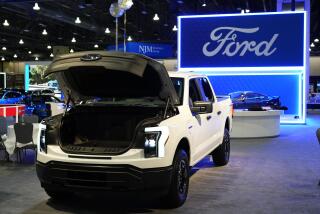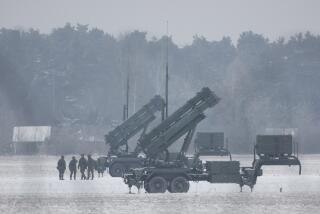Cost Overruns Could Push F-22 Price Up by 23%
- Share via
WASHINGTON — As Lockheed Martin Corp. prepares for next week’s unveiling of the first F-22 jet fighter, an ugly new controversy has erupted over potential future cost overruns that could push up the weapon’s price tag by 23%.
A Pentagon study estimates the F-22 program will cost $80 billion, up from earlier forecasts of $65 billion for 438 of the supersonic stealth jets.
The new estimate is bound to spark further criticism of the Pentagon’s massive $400-billion plan over the next several decades to buy three new types of tactical jet fighters.
“Even before this estimate came out, it was clear that the three programs were not going to fit into the Pentagon’s long-term spending plan,” said Liesl Heeter, an analyst at the Center for Strategic and Budgetary Assessments, a defense-related think tank.
The new estimate comes at a politically inopportune time, just a month away from a key decision by Defense Secretary William Cohen on future weapons purchases, which puts at risk a number of defense programs.
Cohen defended the F-22 on Friday, saying the Pentagon needs the new jet to meet future missions.
But he said the revised estimate must be taken seriously, and, in a letter to congressional leaders Thursday, he left open the possibility that he would recommend a cut in the number of F-22s the Air Force purchases.
The estimate, made by the Defense Department’s Cost Analysis Improvement Group, is being disputed not only by Lockheed Martin but by some Air Force officials as well.
If a cutback in the number of F-22s on order does occur, it would only further drive up the cost of each F-22, because the overall costs of development and training related to the weapon would have to be spread over a smaller number of aircraft. The Air Force originally wanted to buy more than 700 of the jets, which will be assembled in Marietta, Ga. Other major subcontracting work will be done by Boeing Co. in Seattle, Lockheed Martin in Fort Worth and Palmdale and Hughes Electronics Corp. in El Segundo.
Lockheed Martin executives have said the cost of each F-22 would run to $71 million. But based on the new cost estimates in the Pentagon study, each F-22--with its development, spare parts and ground equipment--would carry a price tag of $183 million. Only the B-2 bomber is a more costly combat plane.
At the same time the Pentagon wants to produce the F-22, it is hoping to produce the F-18E/F and develop the new Joint Strike Fighter.
Critics say the Pentagon does not have enough money to produce all three jets and will not face a military threat in the foreseeable future that warrants such a big program.
“It is totally unaffordable, as well as unnecessary,” said Ret. Adm. Eugene Carroll, a frequent critic of the Pentagon who is an analyst at the Center for Defense Information, another defense-related think tank. “I don’t know why we are continuing to buy airplanes that were designed to defeat the Soviet Union in World War III.”
Tom Burbage, Lockheed Martin vice president and general manager for the F-22, said Friday that the projected cost increases are not valid and that the company will be able to produce the fighters at the current Air Force estimate.
Burbage acknowledged that the engineering development cost for the F-22 has jumped from about $17.2 billion to close to $18.7 billion, including the airframe, engines and government-furnished equipment. The cost increased because of technical difficulties, additional features on the aircraft requested by the Air Force and financial reserves added to guard against future cost increases. But that $1.45-billion overrun can be offset in the later production program, Burbage said.
Lockheed Martin believes its new computerized design technology and other advances will enable it to achieve revolutionary efficiencies in production of the aircraft. The higher Pentagon cost estimates were erroneously based on past programs and involve highly uncertain forecasts of future inflation, Burbage said.
The company believes that by the fourth aircraft, its costs will be only 72% of what they were in building the second aircraft, Burbage said. Normally, aircraft firms can only achieve an 80% cost factor by the fourth aircraft.
More to Read
Inside the business of entertainment
The Wide Shot brings you news, analysis and insights on everything from streaming wars to production — and what it all means for the future.
You may occasionally receive promotional content from the Los Angeles Times.











